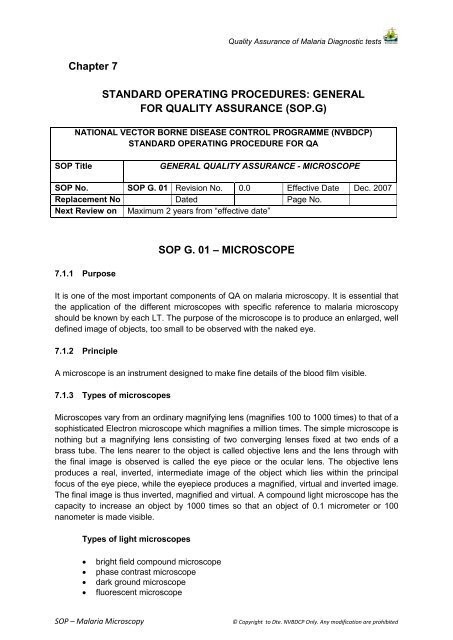SOP â Malaria Microscopy - NVBDCP
SOP â Malaria Microscopy - NVBDCP
SOP â Malaria Microscopy - NVBDCP
Create successful ePaper yourself
Turn your PDF publications into a flip-book with our unique Google optimized e-Paper software.
Quality Assurance of <strong>Malaria</strong> Diagnostic testsChapter 7STANDARD OPERATING PROCEDURES: GENERALFOR QUALITY ASSURANCE (<strong>SOP</strong>.G)NATIONAL VECTOR BORNE DISEASE CONTROL PROGRAMME (<strong>NVBDCP</strong>)STANDARD OPERATING PROCEDURE FOR QA<strong>SOP</strong> TitleGENERAL QUALITY ASSURANCE - MICROSCOPE<strong>SOP</strong> No. <strong>SOP</strong> G. 01 Revision No. 0.0 Effective Date Dec. 2007Replacement No Dated Page No.Next Review on Maximum 2 years from “effective date”7.1.1 Purpose<strong>SOP</strong> G. 01 – MICROSCOPEIt is one of the most important components of QA on malaria microscopy. It is essential thatthe application of the different microscopes with specific reference to malaria microscopyshould be known by each LT. The purpose of the microscope is to produce an enlarged, welldefined image of objects, too small to be observed with the naked eye.7.1.2 PrincipleA microscope is an instrument designed to make fine details of the blood film visible.7.1.3 Types of microscopesMicroscopes vary from an ordinary magnifying lens (magnifies 100 to 1000 times) to that of asophisticated Electron microscope which magnifies a million times. The simple microscope isnothing but a magnifying lens consisting of two converging lenses fixed at two ends of abrass tube. The lens nearer to the object is called objective lens and the lens through withthe final image is observed is called the eye piece or the ocular lens. The objective lensproduces a real, inverted, intermediate image of the object which lies within the principalfocus of the eye piece, while the eyepiece produces a magnified, virtual and inverted image.The final image is thus inverted, magnified and virtual. A compound light microscope has thecapacity to increase an object by 1000 times so that an object of 0.1 micrometer or 100nanometer is made visible.Types of light microscopes• bright field compound microscope• phase contrast microscope• dark ground microscope• fluorescent microscope<strong>SOP</strong> – <strong>Malaria</strong> <strong>Microscopy</strong>© Copyright to Dte. <strong>NVBDCP</strong> Only. Any modification are prohibited
















